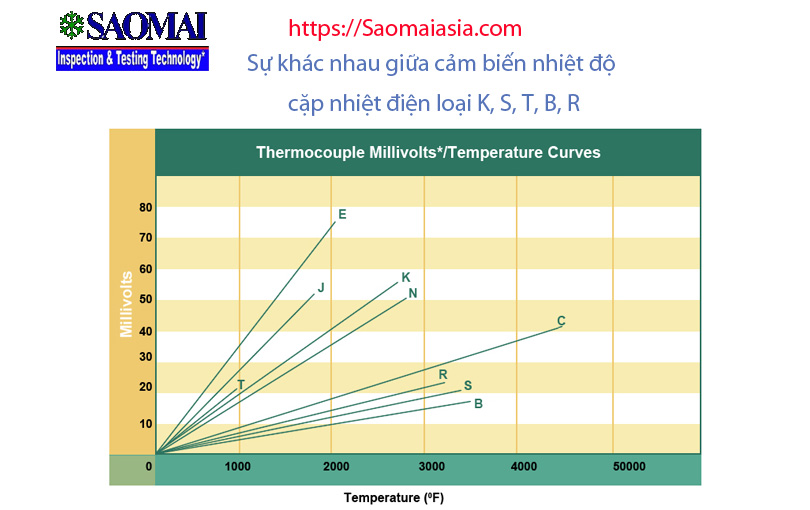Sự khác nhau giữa cảm biến nhiệt độ cặp nhiệt điện loại K, S, T, B, R
Sự khác nhau giữa cảm biến nhiệt độ cặp nhiệt điện loại K, S, T, B, R cơ bản nằm ở vật liệu cảm biến cặp nhiệt điện. Với các vật liệu cặp nhiệt điện khác nhau thì cảm biến nhiệt độ sẽ có khoảng nhiệt độ đo tối ưu khác nhau.

| kinds | Operating temperature limit | Application |
|---|---|---|
| JIS: R | 0 to 1400 (1600)°C | (+) Platinum rhodium alloy containing 13% rhodium (-) Good platinum stability. Suitable for oxidizing atmospheres, but weak for reducing atmospheres. Weak against hydrogen and metal gases. |
| JIS: B | 600 to 1500 (1700)℃ | (+) Platinum rhodium alloy containing 30% rhodium in the leg (-) Platinum rhodium alloy containing 6% rhodium in the leg Heat resistance and mechanical strength are better than R. Since the thermoelectromotive force is small at room temperature, copper wire is used for the compensating lead wire. |
| JIS: S | 0 to 1400 (1600)°C | (+) Platinum rhodium alloy containing 10% rhodium (-) Good platinum stability. Same as R description. |
| JIS: K | -200 to 1000 (1200)°C | (+) Alloy mainly composed of nickel and chrome (-) Alloy mainly composed of nickel The linearity of the thermoelectromotive force is good. Suitable for oxidizing atmospheres. Resistant to metal vapor. Weak against reducing atmosphere. (Especially hydrogen sulfide and sulfurous acid gas) |
| JIS:T | -200 to 300 (350)°C | (+) Leg copper (-) Leg copper and nickel are the main alloys with good homogeneity. Good accuracy at low temperatures. |
| JIS:E | -200 to 700 (800)°C | (+) An alloy mainly composed of nickel and chromium (-) An alloy mainly composed of copper and nickel The thermoelectromotive force is large. More corrosion resistant than J. |
| JIS:J | 0 to 600 (750)°C | Alloy mainly composed of (+) iron (-) copper and nickel . Suitable for reducing atmospheres (stable against hydrogen and carbon monoxide). Homogeneity is not good. It rusts easily. |
| JIS: N | 0 to 1200 (1250)°C | The thermoelectromotive force of the (+) leg nickel-chromium-silicon alloy is smaller than that of the (-) leg nickel-silicon alloy K. Excellent stability at high temperature. |
| Tungsten rhenium (W95Re5-W74Re26) |
0 to 2300 (3000)°C | Tungsten-rhenium alloy containing about 5% rhenium in the (+) leg Tungsten-rhenium alloy containing about 26% rhenium in the (-) leg Suitable for pyrometry. Cannot be used in an oxidizing atmosphere. Suitable for inert gas and hydrogen gas. The thermoelectromotive force is relatively large. Hard and difficult to bend. |
| PlatinelⅡ _ |
0 to 1300℃ | (+) Leg platinum/palladium/gold alloy (-) leg Palladium/gold alloy K thermocouple features. It is said to be superior to K near 1300°C. |
| Platinum Rhodium 40-20 (Pt60Rh40-Pt80Rh20) |
0 to 1800℃ | (+) Platinum rhodium alloy containing 40% rhodium in the (-) leg Platinum rhodium alloy containing 20% rhodium B The thermoelectric force is smaller than the thermocouple. |
| Gold-Platinum (Au-Pt) |
0 to 1000℃ | (+) metal leg (-) Used as a platinum standard thermocouple. Wire diameter φ0.5mm. Small electromotive force drift at high temperature. |
| Platinum-palladium (Pt-Pd) |
0 to 1300℃ | Used as (+) leg platinum (-) leg palladium standard thermocouple. Wire diameter φ0.5mm. Good stability at high temperature. |
Phạm vi nhiệt độ trong ( ) là giới hạn quá nhiệt.
Nhiệt độ quá nóng là giới hạn nhiệt độ mà sản phẩm có thể được sử dụng trong thời gian ngắn trong những trường hợp không thể tránh khỏi.
Ngoài ra, trong tiêu chuẩn DIN (Đức) còn có 2 loại: cặp nhiệt điện U (tương tự T) và cặp nhiệt điện L (tương tự J).
Để tìm thêm thông tin về các sản phẩm liên quan đến nhiệt độ quý khách hàng có thể tham khảo một số sản phẩm chất lượng cao của Nhật Bản như sau:
Để có thể liên hệ trực tiếp với chúng tôi mong quý khách hàng liên hệ trực tiếp với hotline công ty: 0987622004 hoặc để lại số điện thoại trong phần chat để chúng tôi có thể hỗ trợ quý khách hàng tốt nhất.








 Online: 2
Online: 2
 Tổng truy cập: 64235
Tổng truy cập: 64235








